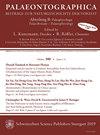巴西亚马逊河Solimões盆地新近纪孢粉学
IF 1.6
3区 地球科学
Q2 Earth and Planetary Sciences
Palaeontographica Abteilung B-Palaeophytologie Palaeobotany-Palaeophytology
Pub Date : 2010-11-02
DOI:10.1127/PALB/284/2010/13
引用次数: 83
摘要
南美洲热带地区拥有世界上最大的植物多样性,但导致这种高度多样性的起源和过程仍然难以捉摸。亚马逊地区新近纪的沉积和化石记录可能为了解亚马逊森林的演变提供重要线索。本文对巴西西北部伊基托斯拱门以东新近系Solimões组两个岩心的花粉和孢子记录进行了研究。我们研究了41个孢粉样品,并使用多种技术对结果进行了分析,包括单一关联、定量生物地层技术和多维尺度分析。我们描述了109个物种,其中51个是新物种,还有7个新组合。生物地层分析表明,研究区Solimões组的时代为晚中新世/上新世早期。这一年龄比伊基托斯拱西侧附近剖面的年龄要小,说明伊基托斯拱在Solimões组的聚集过程中是活跃的。花粉/孢子组合表明Solimões沉积在河流沉积物中。我们没有发现海洋/潮滩沉积物或广泛湖泊的证据。本文章由计算机程序翻译,如有差异,请以英文原文为准。
Neogene palynology of the Solimões Basin, Brazilian Amazonia
The tropics of South America hold the largest plant diversity in the world, yet the origins and processes leading to this high diversity still remain elusive. The Neogene sedimentary and fossil record of Amazonia could contain important clues to understanding the evolution of the Amazonian forest. Here, we study the pollen and spore record of two drill cores of the Neogene Solimões Formation taken in northwestern Brazil, east of the Iquitos Arch. We studied 41 palynological samples and used several techniques to analyze the results, including Unitary Associations, a quantitative biostratigraphic technique, and Multidimensional Scaling Analysis. We describe 109 species, 51 of which are new, and seven new combinations. The biostratigraphic analysis indicates that the age of the Solimões Formation in the study area is Late Miocene/Early Pliocene. This age is younger than that of nearby sections located west of the Iquitos arch, suggesting that the Iquitos Arch was active during the accumulation of the Solimões Formation. The pollen/spore assemblages indicate that the Solimões accumulated in fluvial deposits. We did not find evidence of either marine/tidal-flat deposits or extensive lakes.
求助全文
通过发布文献求助,成功后即可免费获取论文全文。
去求助
来源期刊
CiteScore
3.90
自引率
0.00%
发文量
1
审稿时长
>12 weeks
期刊介绍:
Section B of Palaeontographica publishes contributions to palaeobotany, i.e. papers on morphological traits, systematics and phylogenetic features of plants as well as papers on palaeoclimatology and palynogeography. Especially worth mentioning are the comprehensive monographs published in Palaeontographica B on specific floras or plant groups. Often palaeoclimatic or stratigraphic problems are clarified by resorting to palaeobotanical data published in Section B of Palaeontographica.
Throughout the last decades, numerous objects important to palaeophytology have been found in many places all over the world. As Palaeontographica publishes papers on floras on any parts of the world to report world-wide research, contributions in German, English and French have been published since the beginning of the journal, today English language publications are preferred.
Palaeontographica B is of interest to palaeobotanists, palynologists, palaeoclimatologists, stratigraphers and the libraries of all institutions engaging in such research.

 求助内容:
求助内容: 应助结果提醒方式:
应助结果提醒方式:


